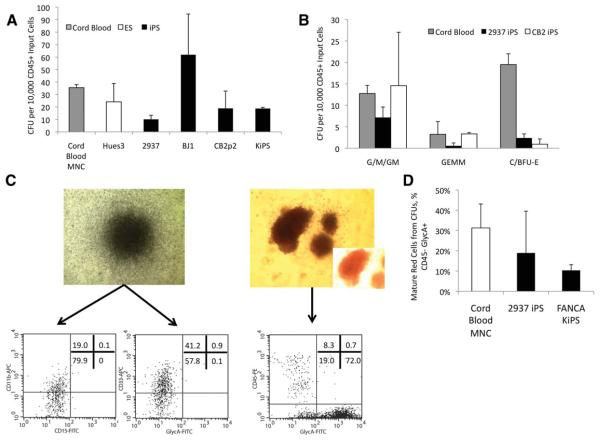Figure 5.
Multiple human embryonic stem cell (ESC) and induced pluripotent stem cell (iPSC) lines yield multipotent myeloid progenitors at frequencies comparable to those of umbilical cord blood mononuclear cells (UCBMNC). Panel (A) shows the number of colony forming unit (CFU) from both cord blood mononuclear cell (UBMNC) isolates and iPSC-derived hematopoietic cells per 10,000 CD45+ input cells. Panel (B) shows the numbers of generated CFUs categorized by colony type from UBMNC, the 2937 iPSC line and CB with CFU-G/M/GM, more primitive CFU-granulocytes, erythrocytes, monocytes, and megakaryocytes colonies as well as erythroid B/CFU-E colonies. (C): Bright-field microscopy and flow cytometric analysis showing common myeloid cell markers (CD11b, CD15, and CD33) from a representative CFU-GM colony (left), and the mature erythroid cell markers (CD45−/GlycophorinA+) from a representative burst forming unit erythroid colony derived from the FA404-KiPSC line (right). The flow cytometry plot demonstrates a high proportion of cells being CD45− and GlycophorinA+, indicative of a committed erythroid cell. (D): Summary histogram plots of numbers of CD45−/GlycophorinA+ mature erythrocytes for the iPSC lines 2937 and FA404-KiPSC in comparison with UCBMNC isolates. White bars indicate hematopoietic cells derived from human ESC lines, black bars from human iPSC lines, and the gray bar from human UCBMNC isolates. Together, these data show the ability for multiple ESC/iPSC lines to generate high numbers of progenitors of both the myeloid and erythroid cell lineages at frequencies comparable to UCBMNC isolates. Abbreviations: APC, allophycocyanin; BFU-E, burst forming unit erythroid; CFU, colony forming unit; ESC, embryonic stem cell; FITC, fluorescein isothiocyanate; GEMM, granulocytes, erythrocytes, monocytes, and megakaryocytes, G/M/GM, granulocyte/monocyte/granulocyte, monocyte; iPSC, induced pluripotent stem cell; KiPSC, keratinocyte-induced pluripotent stem cell; MNC, mononuclear cell; PE, R-phycoerythrin.

